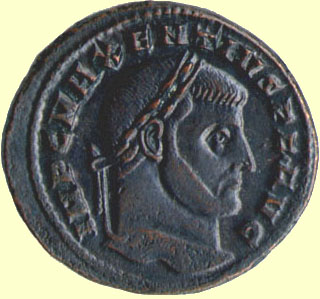 Contents -
Previous Article -
Next Article
Contents -
Previous Article -
Next Article
Maxentius was the popular son of the Roman Emperor Maximianus who ruled in the West from A. D. 286 until Diocletian forced him to abdicate in 305. He was the leader of a rebellion against the emperor Galerius that was very successful for six years.
From the early days of the Republic, the citizens of the city of Rome had never had to pay taxes. Rome was the capital city of a growing empire and her citizens were considered privileged. All this had changed by the beginning of the Fourth Century. The provinces were the areas of greatest political importance and none of the six rulers of the empire in the year A. D. 306 kept his residence or the center of his government at the venerable old city. In light of this, Galerius decided that Rome should be taxed just like any other province.
Naturally, the citizens of Rome were outraged. They rose in rebellion and chose Maxentius as their leader. He immediately invited his father Maximianus to come out of retirement and join him on the throne. Together they took and held Italy from Galerius. They invited Constantine to join their rebellion and Constantine threw in his lot with them, declaring himself Augustus in the process.
The pair were quite successful at defending themselves from Galerius' attempts to retake Rome and Italy. Galerius sent Severus II, Augustus in the West, to deal with the uprising. Maxentius had his agents bribe Severus’ troops and many deserted. Severus was captured in 307 and later put to death.
At this point, Maxentius and his father had an argument and Maximianus felt it necessary to flee to Constantine's court for protection against his son. There were now three factions fighting for control of the empire and it seemed that the situation had deteriorated to the state of civil war that had existed during the Third Century before Diocletian reformed the government and put an end to it. Because of this, Galerius decided to call a peace conference in 308 at Carnuntum on the Danube. Diocletian himself came out of retirement to preside over it.
As a result of the Council of Carnuntum, Maxentius found himself declared a public enemy and his father was again forced to abdicate. Constantine was reduced to the rank of Caesar and Licinius was made Augustus in the West to replace the unfortunate Severus II.
Maxentius held onto Italy for another four years. By that time, Galerius had died and Constantine had formed an alliance with Licinius. Constantine was making plans for an invasion of Italy. Also, the citizens of Rome had begun to doubt the courage of their hero in the face of danger. Maxentius seemed less and less willing to meet his foes as time went on.
The fateful battle took place at the Milvian Bridge in Rome on October 28, A. D. 312. Constantine had had a vision the night before, in which he saw the sign of Christ in the sky and the words in Latin reading "IN HOC SIGNO VINCES" meaning, "In this sign shalt thou conquer!" Constantine interpreted this to mean that he should place the sign of Christ on his standards and shields.
True to the prediction in his vision, Constantine vanquished his foe on the day of battle and routed his army. Maxentius was thrown from the Milvian Bridge into the waters of the Tiber and drowned by the weight of his armor. His body was recovered from the mud the next day.
Go to next article on Romulus
Go back to previous article on Emperor Constantine I (The Great)